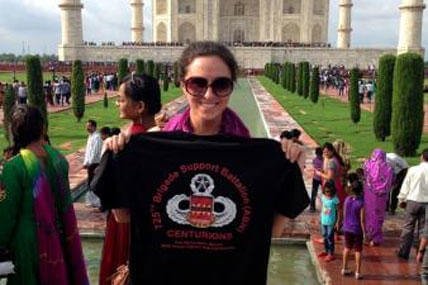JOINT BASE ELEMENDORF-RICHARDSON, Alaska – Army 1st Lt. Laura Condyles, a parachute rigger-qualified officer with the 725th Brigade Support Battalion, recently returned from graduating second place at the Indian army’s Heavy Drop Course in Agra, India.
Condyles, a 25-year-old quartermaster officer from Mechanicsville, Va., was chosen from a distinct group of officers in her unit to attend the course at the Army Airborne Training School. The 52-day event began in early August in one of the hottest areas in India with average daily temperatures hovering around 105 degrees Fahrenheit.
“When I first got there, we found out that the class wasn’t in English. The whole class was in Hindi the entire time!” Condyles said. “They had an old dictionary they used to translate the tests for me.”
Fortunately, the Indian army assigned student-sponsor Capt. Ashish Jha to help Condyles as they both worked through the course. Condyles had to pass three, three-hour written examinations.
“Of course, the questions were originally in Hindi and were translated to English, so I just kind of had to take my best guess at what they were saying,” Condyles said.
The Indian army’s AATS installation is similar to Fort Benning, Ga., Condyles said. Most of their airborne training takes place there, including airborne school, the heavy drop riggers course, high altitude low opening school, and the pathfinder school.
The Indian forces have two main aircraft used for heavy drops, the Russian-made AN-32 and the IL-76, which are comparable in size to the American C-130 and C-17, respectively.
India’s air force packs all of their personnel parachutes, and their army focuses on heavy drop rigging.
The Russian-engineered rigging equipment uses three different platforms. “With each platform, there were three different parachutes that we learned, so I learned how to pack nine different parachutes,” Condyles said.
Condyles excelled in the heavy drop course and earned the Indian army’s Medal of Excellence for achieving the coveted “i” indicator meaning she performed at such a high level that she is qualified to be an instructor.
“I’m the first foreign officer that’s ever gotten the “i” grade before, so that was pretty neat.” she said “The cool thing was I’m the first American that went to the course.”
Condyles said she was fortunate that Capt. Jha was there to translate. In addition, she was able to learn a great deal about the Indian army and India’s culture during her time there.
“They drop live animals,” she said. “They put chickens and goats on a platform and drop them in for food.”
One of the benefits of partnership training is learning about different military organizations, she said.
The Indian army’s structure “is pretty different. Officers, soldiers, and NCOs are very, very separated. It’s not like our Army where we work together a lot more closely,” Condyles said. “When you are an officer on post, they cook your meal for you, or they deliver it to your room. They clean your bathroom for you every day. They mop your floors in your room every day. They even make your bed for you every day, and they do your laundry every single day.”
Even with the conveniences, Condyles’ said her training in India was complicated by the high temperatures, and power outages. “I had electricity about 40 to 50 percent of the time.”
Condyles purchased Indian clothes to wear for her cultural and historical experiences, including two trips to the Taj Mahal, a visit to the historic Agra Fort, a village wedding celebration experience, and sadly, a mourning ceremony for an instructor’s 22-year-old son who was struck and killed by a train.
Condyles thought the training was very worthwhile, and she hopes for more U.S.-Indian military cross-training events to further improve interoperability between the two countries.
“The Indian army is very professional and very disciplined,” she said. “I had a great time training and getting to work with them. I would love to work with them again in the future, and I think our military would benefit greatly from working with them. We could learn from each other.”



























